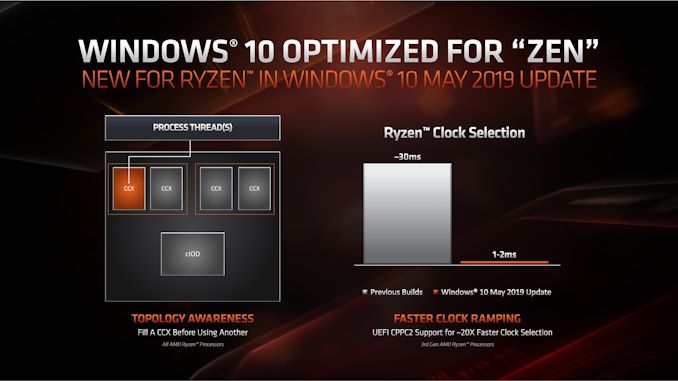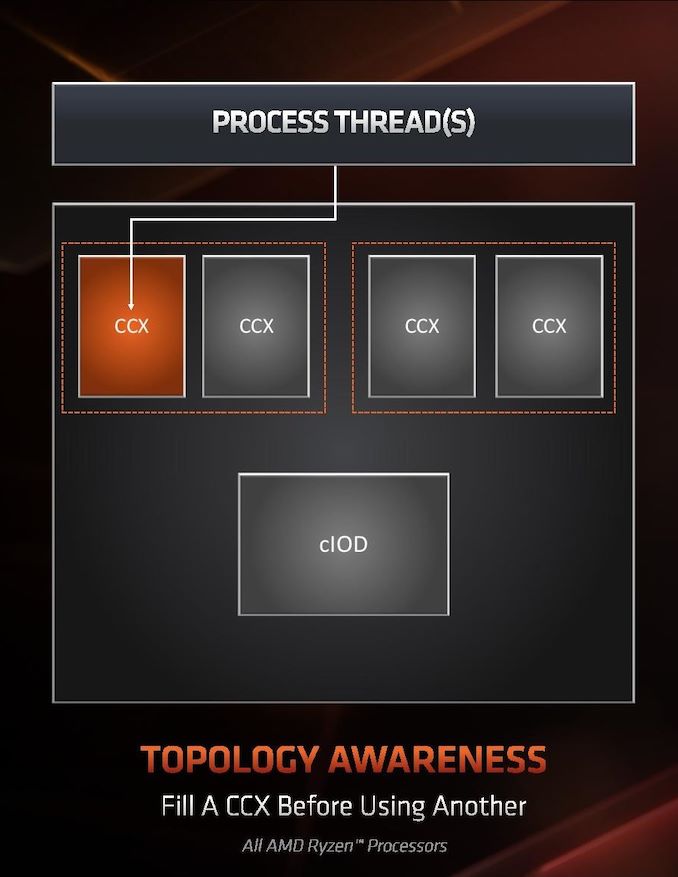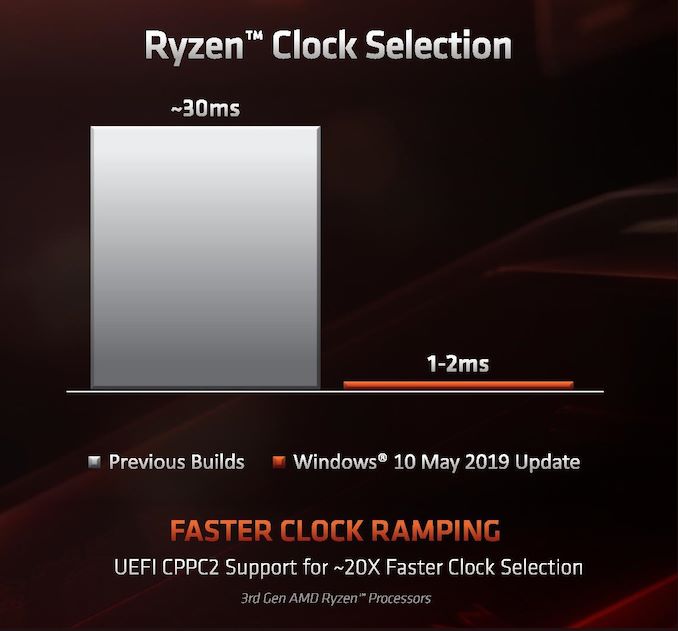The AMD 3rd Gen Ryzen Deep Dive Review: 3700X and 3900X Raising The Bar
by Andrei Frumusanu & Gavin Bonshor on July 7, 2019 9:00 AM ESTSection by Dr. Ian Cutress (Orignal article)
Windows Optimizations
One of the key points that have been a pain in the side of non-Intel processors using Windows has been the optimizations and scheduler arrangements in the operating system. We’ve seen in the past how Windows has not been kind to non-Intel microarchitecture layouts, such as AMD’s previous module design in Bulldozer, the Qualcomm hybrid CPU strategy with Windows on Snapdragon, and more recently with multi-die arrangements on Threadripper that introduce different memory latency domains into consumer computing.
Obviously AMD has a close relationship with Microsoft when it comes down to identifying a non-regular core topology with a processor, and the two companies work towards ensuring that thread and memory assignments, absent of program driven direction, attempt to make the most out of the system. With the May 10th update to Windows, some additional features have been put in place to get the most out of the upcoming Zen 2 microarchitecture and Ryzen 3000 silicon layouts.
The optimizations come on two fronts, both of which are reasonably easy to explain.
Thread Grouping
The first is thread allocation. When a processor has different ‘groups’ of CPU cores, there are different ways in which threads are allocated, all of which have pros and cons. The two extremes for thread allocation come down to thread grouping and thread expansion.
Thread grouping is where as new threads are spawned, they will be allocated onto cores directly next to cores that already have threads. This keeps the threads close together, for thread-to-thread communication, however it can create regions of high power density, especially when there are many cores on the processor but only a couple are active.
Thread expansion is where cores are placed as far away from each other as possible. In AMD’s case, this would mean a second thread spawning on a different chiplet, or a different core complex/CCX, as far away as possible. This allows the CPU to maintain high performance by not having regions of high power density, typically providing the best turbo performance across multiple threads.
The danger of thread expansion is when a program spawns two threads that end up on different sides of the CPU. In Threadripper, this could even mean that the second thread was on a part of the CPU that had a long memory latency, causing an imbalance in the potential performance between the two threads, even though the cores those threads were on would have been at the higher turbo frequency.
Because of how modern software, and in particular video games, are now spawning multiple threads rather than relying on a single thread, and those threads need to talk to each other, AMD is moving from a hybrid thread expansion technique to a thread grouping technique. This means that one CCX will fill up with threads before another CCX is even accessed. AMD believes that despite the potential for high power density within a chiplet, while the other might be inactive, is still worth it for overall performance.
For Matisse, this should afford a nice improvement for limited thread scenarios, and on the face of the technology, gaming. It will be interesting to see how much of an affect this has on the upcoming EPYC Rome CPUs or future Threadripper designs. The single benchmark AMD provided in its explanation was Rocket League at 1080p Low, which reported a +15% frame rate gain.
Clock Ramping
For any of our users familiar with our Skylake microarchitecture deep dive, you may remember that Intel introduced a new feature called Speed Shift that enabled the processor to adjust between different P-states more freely, as well as ramping from idle to load very quickly – from 100 ms to 40ms in the first version in Skylake, then down to 15 ms with Kaby Lake. It did this by handing P-state control back from the OS to the processor, which reacted based on instruction throughput and request. With Zen 2, AMD is now enabling the same feature.
AMD already has sufficiently more granularity in its frequency adjustments over Intel, allowing for 25 MHz differences rather than 100 MHz differences, however enabling a faster ramp-to-load frequency jump is going to help AMD when it comes to very burst-driven workloads, such as WebXPRT (Intel’s favorite for this sort of demonstration). According to AMD, the way that this has been implemented with Zen 2 will require BIOS updates as well as moving to the Windows May 10th update, but it will reduce frequency ramping from ~30 milliseconds on Zen to ~1-2 milliseconds on Zen 2. It should be noted that this is much faster than the numbers Intel tends to provide.
The technical name for AMD’s implementation involves CPPC2, or Collaborative Power Performance Control 2, and AMD’s metrics state that this can increase burst workloads and also application loading. AMD cites a +6% performance gain in application launch times using PCMark10’s app launch sub-test.
Hardened Security for Zen 2
Another aspect to Zen 2 is AMD’s approach to heightened security requirements of modern processors. As has been reported, a good number of the recent array of side channel exploits do not affect AMD processors, primarily because of how AMD manages its TLB buffers that have always required additional security checks before most of this became an issue. Nonetheless, for the issues to which AMD is vulnerable, it has implemented a full hardware-based security platform for them.
The change here comes for the Speculative Store Bypass, known as Spectre v4, which AMD now has additional hardware to work in conjunction with the OS or virtual memory managers such as hypervisors in order to control. AMD doesn’t expect any performance change from these updates. Newer issues such as Foreshadow and Zombieload do not affect AMD processors.














447 Comments
View All Comments
Daeros - Monday, July 15, 2019 - link
The only mitigation for MDS is to disable Hyper-Threading. I feel like there would be a pretty significant performance penalty for this.Irata - Sunday, July 7, 2019 - link
Well, at least Ryzen 3000 CPU were tested with the latest Windows build that includes Ryzen optimizations, but tbh I find it a bit "lazy" at least to not test Intel CPU on the latest Windows release which forces security updates that *do* affect performance negatively.This may or may not have changed the final results but would be more proper.
Oxford Guy - Sunday, July 7, 2019 - link
Lazy doesn't even begin to describe it.Irata - Sunday, July 7, 2019 - link
Thing is I find this so completely unnecessary.Not criticising thereview per se, but you see AT staff going wild on Twitter over people accusing them of bias when simple things like testing both Intel and AMD systems on the same Windows version would be an easy way to protect themselves against criticism.
It the same as the budget CPU review where the Pentium Gold was recommended due to its price/ performance, but many posters pointed out that it simply was not available anywhere for even near the suggested price and AT failed to acknowledge that.
Zombieload ? Never heard of it.
This is what I mean by lazy - acknowledge these issues or at least give a logical reason why. This is much easier than being offended on Twitter. If you say why you did certain things, there is no reason to post "Because they crap over the comment sections with such vitriol; they're so incensed that we did XYZ, to the point where they're prepared to spend half an hour writing comments to that effect with the most condescending language. " which basically comes down to saying "A ton of our readers are a*holes.
Sure, PC related comment sections can be extremely toxic, but doing things as proper as possible is a good way to safeguard against such comments or at least make those complaining look like ignorant fools rather than actually encouraging this.
John_M - Sunday, July 7, 2019 - link
A good point and you made it very well and in a very civil way.Ryan Smith - Monday, July 8, 2019 - link
Thanks. I appreciate the feedback, as I know first hand it can sometimes be hard to write something useful.When AMD told us that there were important scheduler changes in 1903, Ian and I both groaned a bit. We're glad AMD is getting some much-needed attention from Microsoft with regards to thread scheduling. But we generally would avoid using such a fresh OS, after the disasters that were the 1803 and 1809 launches.
And more to the point, the timeframe for this review didn't leave us nearly enough time to redo everything on 1903. With the AMD processors arriving on Wednesday, and with all the prep work required up to that, the best we could do in the time available was run the Ryzen 3000 parts on 1903, ensuring that we tested AMD's processor with the scheduler it was meant for. I had been pushing hard to try to get at least some of the most important stuff redone on 1903, but unfortunately that just didn't work out.
Ultimately laziness definitely was not part of the reason for anything we did. Andrei and Gavin went above and beyond, giving up their weekends and family time in order to get this review done for today. As it stands, we're all beat, and the work week hasn't even started yet...
(I'll also add that AnandTech is not a centralized operation; Ian is in London, I'm on the US west coast, etc. It brings us some great benefits, but it also means that we can't easily hand off hardware to other people to ramp up testing in a crunch period.)
RSAUser - Monday, July 8, 2019 - link
But you already had the Intel processors beforehand so could have tested them on 1903 without having to wait for the Ryzen CPU? Your argument is weird.Daeros - Monday, July 15, 2019 - link
Exactly. They knew that they needed to re-test the Intel and older Ryzen chips on 1903 to have a level, relevant playing field. Knowing that it would penalize Intel disproportionately to have all the mitigations 1903 bakes in, they simply chose not to.Targon - Monday, July 8, 2019 - link
Sorry, Ryan, but test beds are not your "daily drivers". With 1903 out for more than one month, a fresh install of 1903(Windows 10 Media Creation tool comes in handy), with the latest chipset and device drivers, it should have been possible to fully re-test the Intel platform with all the latest security patches, BIOS updates, etc. The Intel platform should have been set and re-benchmarked before the samples from AMD even showed up.It would have been good to see proper RAM used, because anyone who buys DDR4-3200 RAM with the intention of gaming would go with DDR4-3200CL14 RAM, not the CL16 stuff that was used in the new Ryzen setup. The only reason I went CL16 with my Ryzen setup was because when pre-ordering Ryzen 7 in 2017, it wasn't known at the time how significant CL14 vs. CL16 RAM would be in terms of performance and stability(and even the ability to run at DDR4-3200 speeds).
If I were doing reviews, I'd have DDR4-3200 in various flavors from the various systems being used. Taking the better stuff out of another system to do a proper test would be expected.
Ratman6161 - Thursday, July 11, 2019 - link
"ho buys DDR4-3200 RAM with the intention of gaming would go with DDR4-3200CL14 RAM"Well I can tell you who. First Ill address "the intention of gaming". there are a lot of us who could care less about games and I am one of them. Second, even for those who do play games, if you need 32 GB of RAM (like I do) the difference in price on New Egg between CAS 16 and CAS 14 for a 2x16 Kit is $115 (comparing RipJaws CAS 16 Vs Trident Z CAS 14 - both G-Skill obviously). That's approaching double the price. So I sort of appreciate reviews that use the RAM I would actually buy. I'm sure gamers on a budget who either can't or don't want to spend the extra $115 or would rather put it against a better video card, the cheaper RAM is a good trade off.
Finally, there are going to be a zillion reviews of these processors over the next few days and weeks. We don't necessarily need to get every single possible configuration covered the first day :) Also, there are many other sites publishing reviews so its easy to find sites using different configurations. All in all, I don't know why people are being so harsh on this (and other) reviews. its not like I paid to read it :)